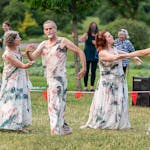What or who is even "American" these days?
The Minnesota Museum of American Art wants to know. It tapped four Twin Cities curators to answer that question in a large-scale exhibition with more than 40 works by artists from a wide range of backgrounds, races, sexualities and genders.
The exhibit occupies the two corner galleries of the museum, which is in the process of expanding across the hallway of the historic Pioneer-Endicott buildings in St. Paul, designed in part by Minnesota State Capitol architect Cass Gilbert. The additional 20,000 square feet of space is on track to open early next summer.
Johnnay Leenay focuses her section on queer, transgender and gender-nonconforming individuals who face discrimination and are also on the forefront of social justice work.
"When I was tasked with how do you define 'America' or 'we the people,' I felt like in today's climate a lot of my identities are getting attacked — being a person of color, being queer, being a woman," said Leenay, who is also the museum's Diversity in the Arts Curatorial Fellow. "So I felt like, to really even begin to give one of those light, I needed to intentionally focus on one. I chose queerness because it is not always a visible identity and this exhibition gave me the opportunity to explore it through an artistic lens."
Her section includes a series called "Butch Heroes" by Ria Brodell, who researched the history of transgender people in the United States and discovered three individuals who lived beyond the gender binary before there were terms like transgender, queer, lesbian, or even butch/femme/androgynous. Each illustrative drawing looks like a trading card of sorts, with the term "Butch Heroes" at the top. One depicts Sammy Williams, who lived and worked as a lumberjack and camp cook, and was known as a ladies man and also "strong as an ox." After his death in 1908, female genitalia were discovered; mainstream newspapers at the time struggled to understand what this meant.
In artist Christopher Harrison's section, he focused on the sub-themes of home, travel, immigration, nostalgia and identity. Nooshin Hakim's piece "11000 KM of Hope" (2017) is a hanging pair of worn-down kids' shoes, encrusted with thick layers of aquamarine and deep blue shards of crystals, a testament to the arrival marked by the Statue of Liberty, where America is poised as a refuge.
Mary Anne Quiroz's section speaks to her own experiences as an immigrant from the Philippines, a woman, and someone who works closely and creatively with her family members. With her husband, Sergio Cenoch Quiroz, who is from Mexico, she runs the traditional Aztec dance and drum group Kalpulli Yaocenoxtli. They are also co-founders of Indigenous Roots Cultural Arts Center in St. Paul.
"I wanted to really share some of those experiences as an Asian-American and also for my children who are mixed-race/Mexican heritage," said Quiroz. "I also wanted to make sure that indigenous artists — Native Americans — were represented in my section."
Todd Bordeaux's "Story Stick #1" (1997) and "Story Stick #7" (2007) are wooden sticks covered with glass beads, feathers and deer antlers that include pictographs of stories drawn from his family history as a member of the Sicangu Lakota Oyate tribe of South Dakota. The pictographs are accompanied by a guide; an image of a buffalo, for instance, represents how in 1850-51, "a buffalo was taken. An old woman was found in the belly."
Maggie Thompson, an artist who is Ojibwe and also manager at Two Rivers Art Gallery in Minneapolis, uses the works in her section to comment on the dominant white culture's telling of history. She is also inspired by protests at Standing Rock, Black Lives Matter and the Women's March.
In pieces such as "The Weapon Is Sharing (This Machine Kills Fascists)," artist Cannupa Hanska creates facades of iPhone screens using ceramic with text exchanges of images of American Indian protests matched with the consistent response/rallying cry "this machine kills fascists." The incredible amount of technology at Standing Rock made the protests more visible to those who were not there; at the same time, protesters were heavily surveilled using the same technologies.
"I am in love with his narratives and the issues and concepts he chooses to tackle," said Thompson. "Being that he is from Standing Rock is important, because he can talk about it from his own experience."
The curious thing about "We the People" is that it doesn't seek to answer questions about what America will become. Instead, it offers a reflection of what it is right now, a tale that's cautionary yet empowering, and all-encompassing.





